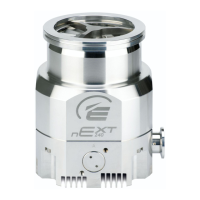© Edwards Limited 2013. All rights reserved. Page 5
Edwards and the Edwards logo are trademarks of Edwards Limited.
Introduction
B800-00-880 Issue D
There are many venting options available, including:
Hard vent when rotational speed drops below 50%
Controlled vent when above 50% speed and hard vent below 50% speed
Hard vent immediately through a suitable restrictor
Controlled venting gives the benefit of a quicker ramp down time by controlling the vent rate through a single large
orifice across the pump speed range. A full list of the venting options is given in Section 3.9
In addition there is a feature that allows a delayed start of the nEXT pump. With this feature, the vent valve can be
closed before starting the nEXT pump. This allows the backing pump to reduce the pressure in the vacuum system
before starting the nEXT pump.
If the controller is not used to control a TAV vent valve, it can be used to run a fan instead. The controller can be
configured so that the fan is permanently enabled.
1.4.6 Normal speed setting
The normal speed is a user-selectable parameter that can be set anywhere from 50% to 100% of full rotational speed.
When the pump reaches normal speed, a signal is available on the normal pin of the logic interface connector. This
signal can be used to control the application since it shows that pump speed, and therefore vacuum performance,
has reached a specific minimum level. The default setting is 80% of full rotational speed. Refer to Section 4.1.5 for
instructions on altering the normal speed setting.
1.5 Logic interface
The pump controller can only be operated through the logic interface. The signals on the logic interface are of three
types:
Control inputs: these are switch-type signals that are used to control the pump
Status outputs: these outputs identify the status of the system
Analogue output: this provides a 0 – 10 V output for a number of pump parameters.
The logic interface has been designed to support both serial and parallel control and monitoring, operating through
one connector. For serial control either RS232 (default) or RS485 can be selected using the RS485/RS232 slide switch
located on the controller (refer to Section 3.7).
The logic interface can be plugged directly into the Edwards TIC Turbo Controller or TIC Turbo Instrument Controller
and then use the functionality that they provide. Alternatively, the logic interface can be connected to the customer
control system. The most useful arrangements are described in the sections below.
For more information about the logic interface, refer to Section 2.8.
1.5.1 Parallel control and monitoring
The simple parallel interface is a quick and easy way to control the pump. This is the same interface used on existing
24 V Edwards Turbo Pumps. The controls that are available to use are start and standby. The system status can be
monitored using the normal, fail and analogue output signals.
Note: The serial enable switch MUST be open (no connection) and the slide switch must be in the RS232 position
(refer to Section 3.7).
Refer to Section 3.6 for more detailed instructions of how to use the parallel interface.

